Information Technology Ethics Assesment
VerifiedAdded on 2022/08/25
|10
|2258
|18
AI Summary
Contribute Materials
Your contribution can guide someone’s learning journey. Share your
documents today.
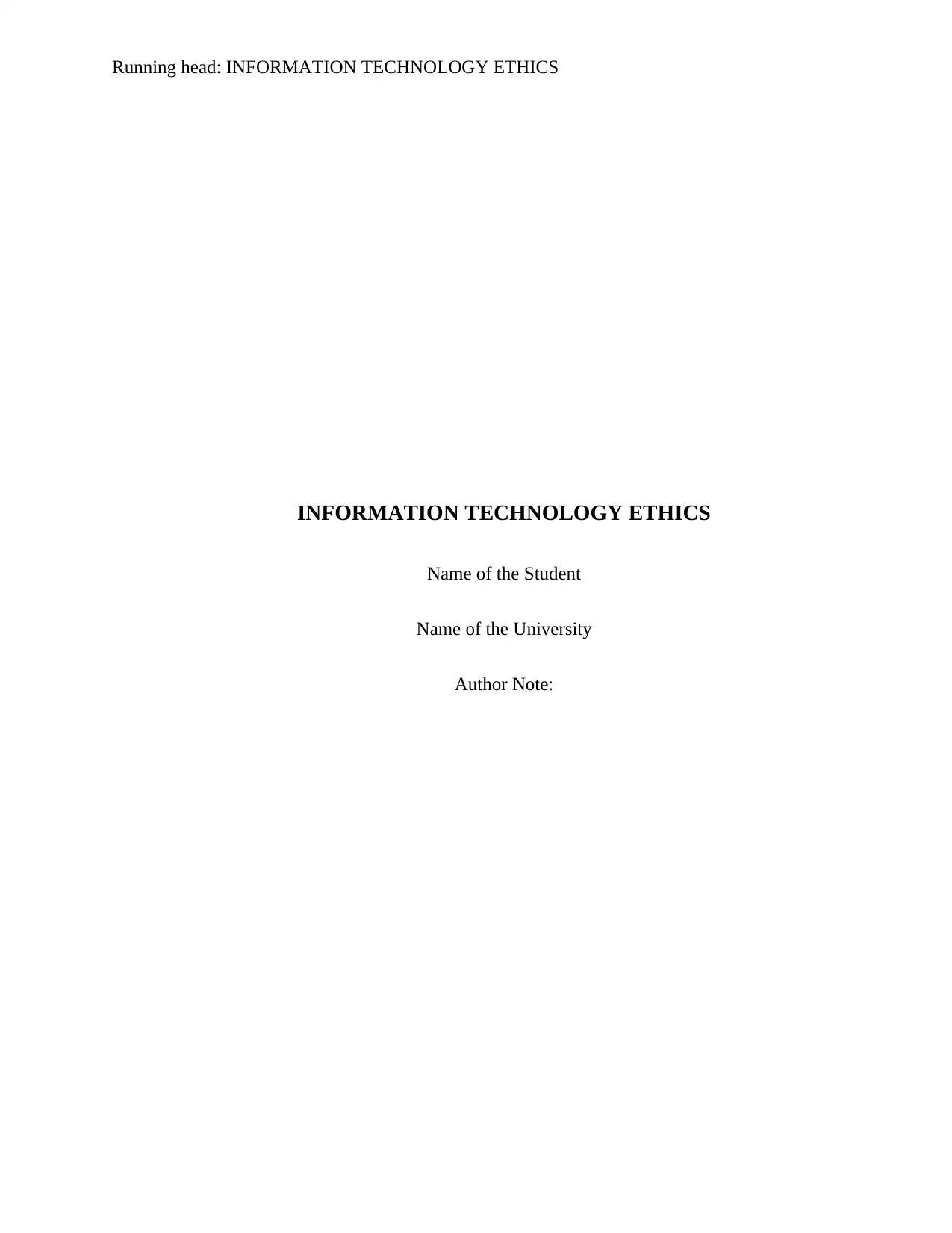
Running head: INFORMATION TECHNOLOGY ETHICS
INFORMATION TECHNOLOGY ETHICS
Name of the Student
Name of the University
Author Note:
INFORMATION TECHNOLOGY ETHICS
Name of the Student
Name of the University
Author Note:
Secure Best Marks with AI Grader
Need help grading? Try our AI Grader for instant feedback on your assignments.
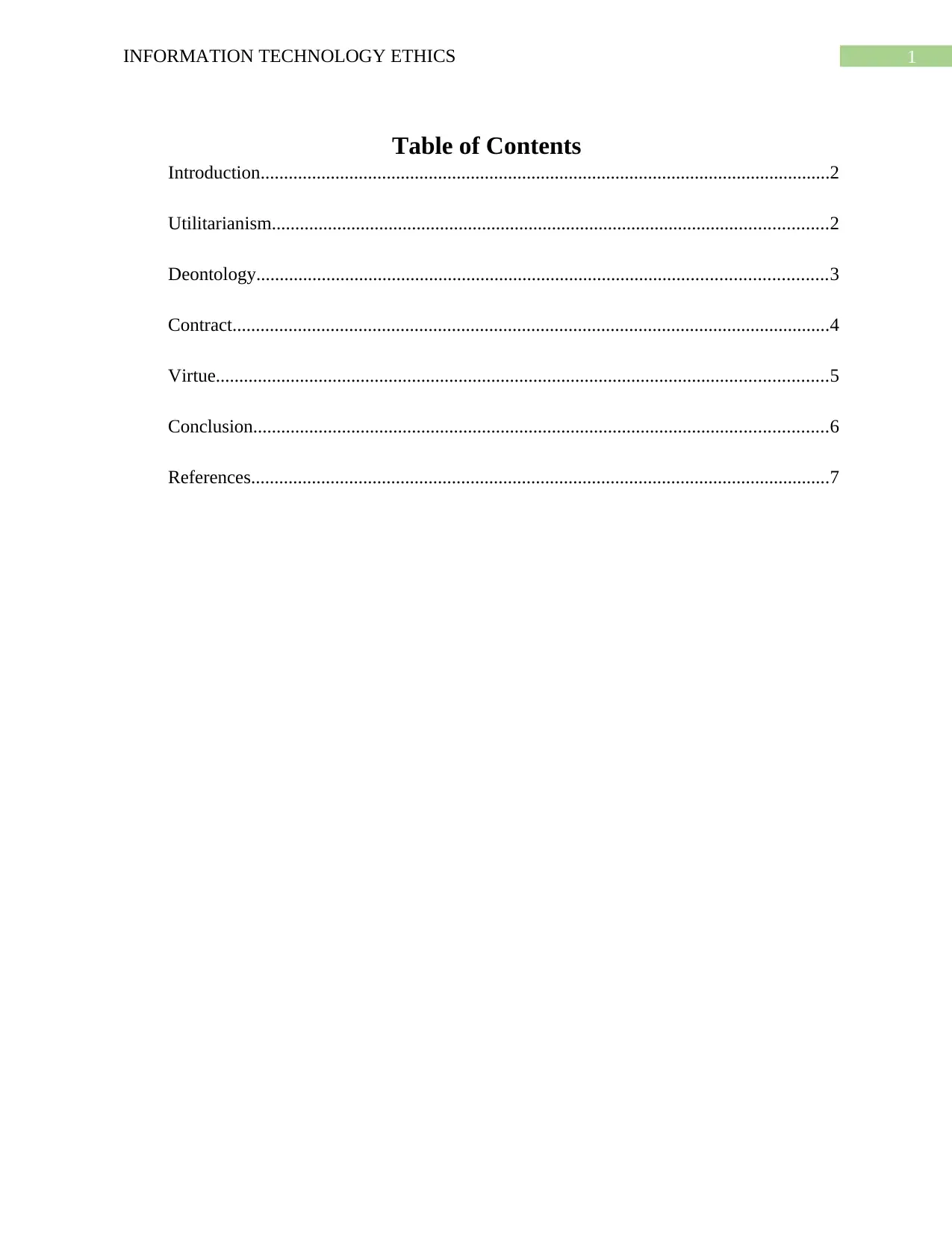
1INFORMATION TECHNOLOGY ETHICS
Table of Contents
Introduction..........................................................................................................................2
Utilitarianism.......................................................................................................................2
Deontology..........................................................................................................................3
Contract................................................................................................................................4
Virtue...................................................................................................................................5
Conclusion...........................................................................................................................6
References............................................................................................................................7
Table of Contents
Introduction..........................................................................................................................2
Utilitarianism.......................................................................................................................2
Deontology..........................................................................................................................3
Contract................................................................................................................................4
Virtue...................................................................................................................................5
Conclusion...........................................................................................................................6
References............................................................................................................................7
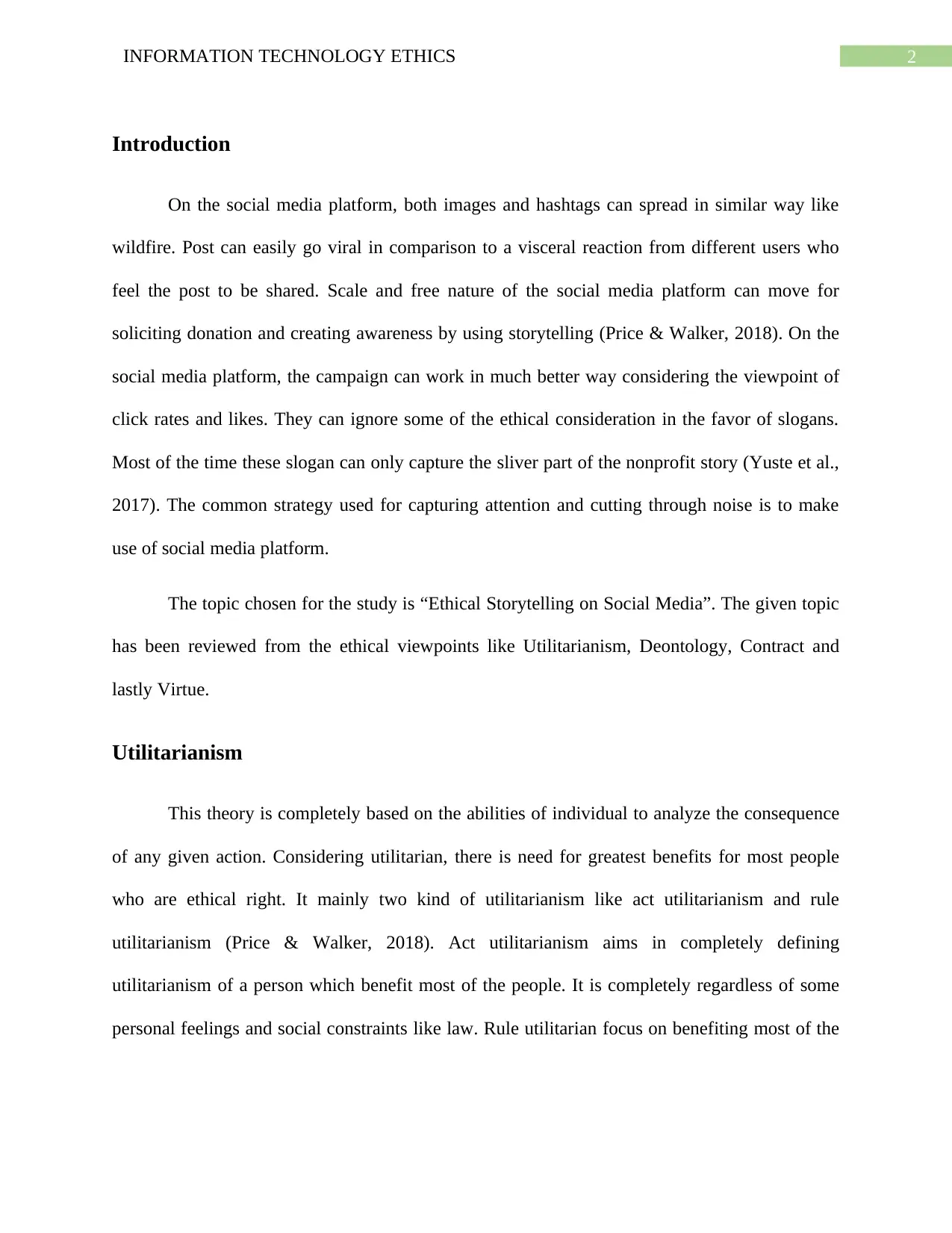
2INFORMATION TECHNOLOGY ETHICS
Introduction
On the social media platform, both images and hashtags can spread in similar way like
wildfire. Post can easily go viral in comparison to a visceral reaction from different users who
feel the post to be shared. Scale and free nature of the social media platform can move for
soliciting donation and creating awareness by using storytelling (Price & Walker, 2018). On the
social media platform, the campaign can work in much better way considering the viewpoint of
click rates and likes. They can ignore some of the ethical consideration in the favor of slogans.
Most of the time these slogan can only capture the sliver part of the nonprofit story (Yuste et al.,
2017). The common strategy used for capturing attention and cutting through noise is to make
use of social media platform.
The topic chosen for the study is “Ethical Storytelling on Social Media”. The given topic
has been reviewed from the ethical viewpoints like Utilitarianism, Deontology, Contract and
lastly Virtue.
Utilitarianism
This theory is completely based on the abilities of individual to analyze the consequence
of any given action. Considering utilitarian, there is need for greatest benefits for most people
who are ethical right. It mainly two kind of utilitarianism like act utilitarianism and rule
utilitarianism (Price & Walker, 2018). Act utilitarianism aims in completely defining
utilitarianism of a person which benefit most of the people. It is completely regardless of some
personal feelings and social constraints like law. Rule utilitarian focus on benefiting most of the
Introduction
On the social media platform, both images and hashtags can spread in similar way like
wildfire. Post can easily go viral in comparison to a visceral reaction from different users who
feel the post to be shared. Scale and free nature of the social media platform can move for
soliciting donation and creating awareness by using storytelling (Price & Walker, 2018). On the
social media platform, the campaign can work in much better way considering the viewpoint of
click rates and likes. They can ignore some of the ethical consideration in the favor of slogans.
Most of the time these slogan can only capture the sliver part of the nonprofit story (Yuste et al.,
2017). The common strategy used for capturing attention and cutting through noise is to make
use of social media platform.
The topic chosen for the study is “Ethical Storytelling on Social Media”. The given topic
has been reviewed from the ethical viewpoints like Utilitarianism, Deontology, Contract and
lastly Virtue.
Utilitarianism
This theory is completely based on the abilities of individual to analyze the consequence
of any given action. Considering utilitarian, there is need for greatest benefits for most people
who are ethical right. It mainly two kind of utilitarianism like act utilitarianism and rule
utilitarianism (Price & Walker, 2018). Act utilitarianism aims in completely defining
utilitarianism of a person which benefit most of the people. It is completely regardless of some
personal feelings and social constraints like law. Rule utilitarian focus on benefiting most of the
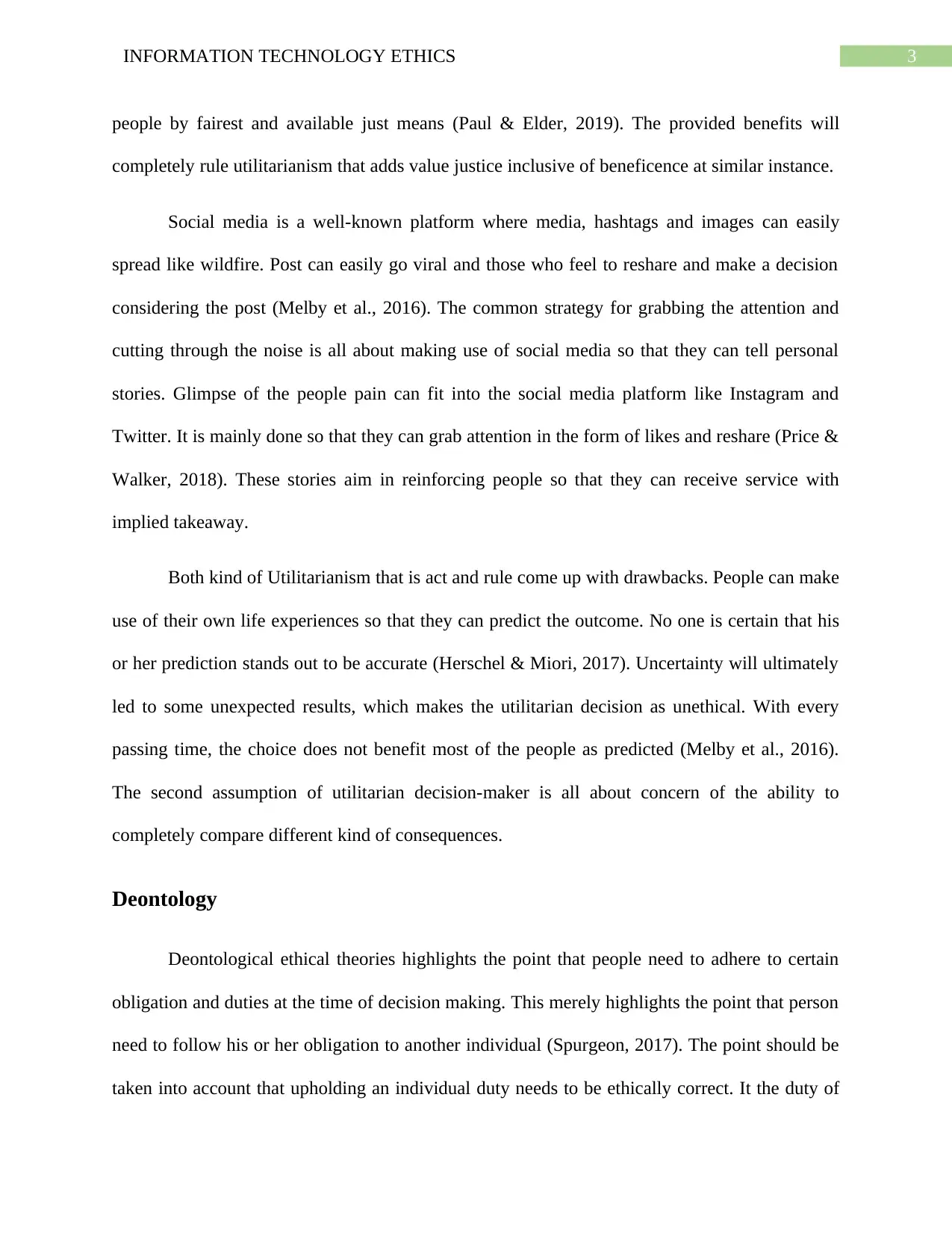
3INFORMATION TECHNOLOGY ETHICS
people by fairest and available just means (Paul & Elder, 2019). The provided benefits will
completely rule utilitarianism that adds value justice inclusive of beneficence at similar instance.
Social media is a well-known platform where media, hashtags and images can easily
spread like wildfire. Post can easily go viral and those who feel to reshare and make a decision
considering the post (Melby et al., 2016). The common strategy for grabbing the attention and
cutting through the noise is all about making use of social media so that they can tell personal
stories. Glimpse of the people pain can fit into the social media platform like Instagram and
Twitter. It is mainly done so that they can grab attention in the form of likes and reshare (Price &
Walker, 2018). These stories aim in reinforcing people so that they can receive service with
implied takeaway.
Both kind of Utilitarianism that is act and rule come up with drawbacks. People can make
use of their own life experiences so that they can predict the outcome. No one is certain that his
or her prediction stands out to be accurate (Herschel & Miori, 2017). Uncertainty will ultimately
led to some unexpected results, which makes the utilitarian decision as unethical. With every
passing time, the choice does not benefit most of the people as predicted (Melby et al., 2016).
The second assumption of utilitarian decision-maker is all about concern of the ability to
completely compare different kind of consequences.
Deontology
Deontological ethical theories highlights the point that people need to adhere to certain
obligation and duties at the time of decision making. This merely highlights the point that person
need to follow his or her obligation to another individual (Spurgeon, 2017). The point should be
taken into account that upholding an individual duty needs to be ethically correct. It the duty of
people by fairest and available just means (Paul & Elder, 2019). The provided benefits will
completely rule utilitarianism that adds value justice inclusive of beneficence at similar instance.
Social media is a well-known platform where media, hashtags and images can easily
spread like wildfire. Post can easily go viral and those who feel to reshare and make a decision
considering the post (Melby et al., 2016). The common strategy for grabbing the attention and
cutting through the noise is all about making use of social media so that they can tell personal
stories. Glimpse of the people pain can fit into the social media platform like Instagram and
Twitter. It is mainly done so that they can grab attention in the form of likes and reshare (Price &
Walker, 2018). These stories aim in reinforcing people so that they can receive service with
implied takeaway.
Both kind of Utilitarianism that is act and rule come up with drawbacks. People can make
use of their own life experiences so that they can predict the outcome. No one is certain that his
or her prediction stands out to be accurate (Herschel & Miori, 2017). Uncertainty will ultimately
led to some unexpected results, which makes the utilitarian decision as unethical. With every
passing time, the choice does not benefit most of the people as predicted (Melby et al., 2016).
The second assumption of utilitarian decision-maker is all about concern of the ability to
completely compare different kind of consequences.
Deontology
Deontological ethical theories highlights the point that people need to adhere to certain
obligation and duties at the time of decision making. This merely highlights the point that person
need to follow his or her obligation to another individual (Spurgeon, 2017). The point should be
taken into account that upholding an individual duty needs to be ethically correct. It the duty of
Secure Best Marks with AI Grader
Need help grading? Try our AI Grader for instant feedback on your assignments.
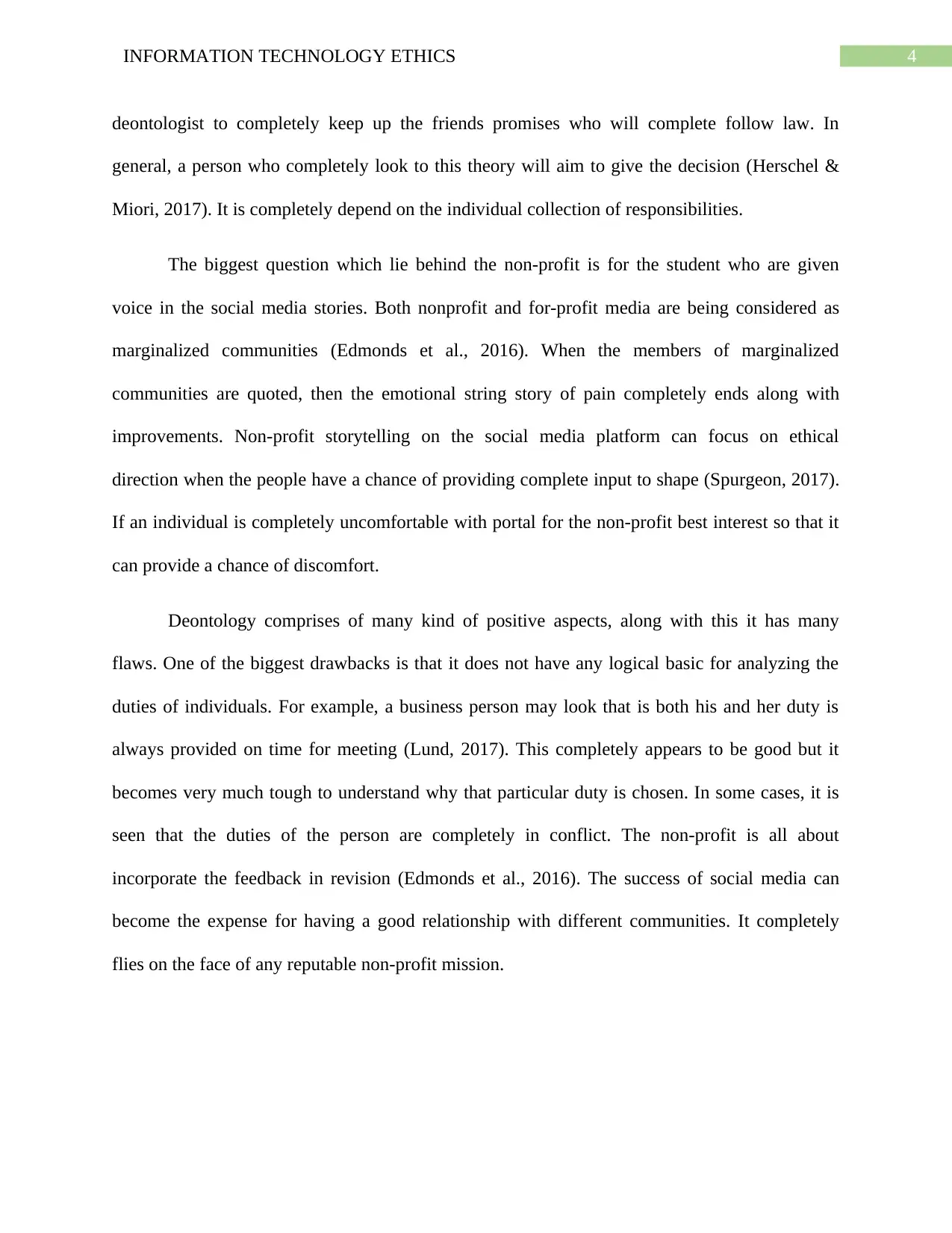
4INFORMATION TECHNOLOGY ETHICS
deontologist to completely keep up the friends promises who will complete follow law. In
general, a person who completely look to this theory will aim to give the decision (Herschel &
Miori, 2017). It is completely depend on the individual collection of responsibilities.
The biggest question which lie behind the non-profit is for the student who are given
voice in the social media stories. Both nonprofit and for-profit media are being considered as
marginalized communities (Edmonds et al., 2016). When the members of marginalized
communities are quoted, then the emotional string story of pain completely ends along with
improvements. Non-profit storytelling on the social media platform can focus on ethical
direction when the people have a chance of providing complete input to shape (Spurgeon, 2017).
If an individual is completely uncomfortable with portal for the non-profit best interest so that it
can provide a chance of discomfort.
Deontology comprises of many kind of positive aspects, along with this it has many
flaws. One of the biggest drawbacks is that it does not have any logical basic for analyzing the
duties of individuals. For example, a business person may look that is both his and her duty is
always provided on time for meeting (Lund, 2017). This completely appears to be good but it
becomes very much tough to understand why that particular duty is chosen. In some cases, it is
seen that the duties of the person are completely in conflict. The non-profit is all about
incorporate the feedback in revision (Edmonds et al., 2016). The success of social media can
become the expense for having a good relationship with different communities. It completely
flies on the face of any reputable non-profit mission.
deontologist to completely keep up the friends promises who will complete follow law. In
general, a person who completely look to this theory will aim to give the decision (Herschel &
Miori, 2017). It is completely depend on the individual collection of responsibilities.
The biggest question which lie behind the non-profit is for the student who are given
voice in the social media stories. Both nonprofit and for-profit media are being considered as
marginalized communities (Edmonds et al., 2016). When the members of marginalized
communities are quoted, then the emotional string story of pain completely ends along with
improvements. Non-profit storytelling on the social media platform can focus on ethical
direction when the people have a chance of providing complete input to shape (Spurgeon, 2017).
If an individual is completely uncomfortable with portal for the non-profit best interest so that it
can provide a chance of discomfort.
Deontology comprises of many kind of positive aspects, along with this it has many
flaws. One of the biggest drawbacks is that it does not have any logical basic for analyzing the
duties of individuals. For example, a business person may look that is both his and her duty is
always provided on time for meeting (Lund, 2017). This completely appears to be good but it
becomes very much tough to understand why that particular duty is chosen. In some cases, it is
seen that the duties of the person are completely in conflict. The non-profit is all about
incorporate the feedback in revision (Edmonds et al., 2016). The success of social media can
become the expense for having a good relationship with different communities. It completely
flies on the face of any reputable non-profit mission.
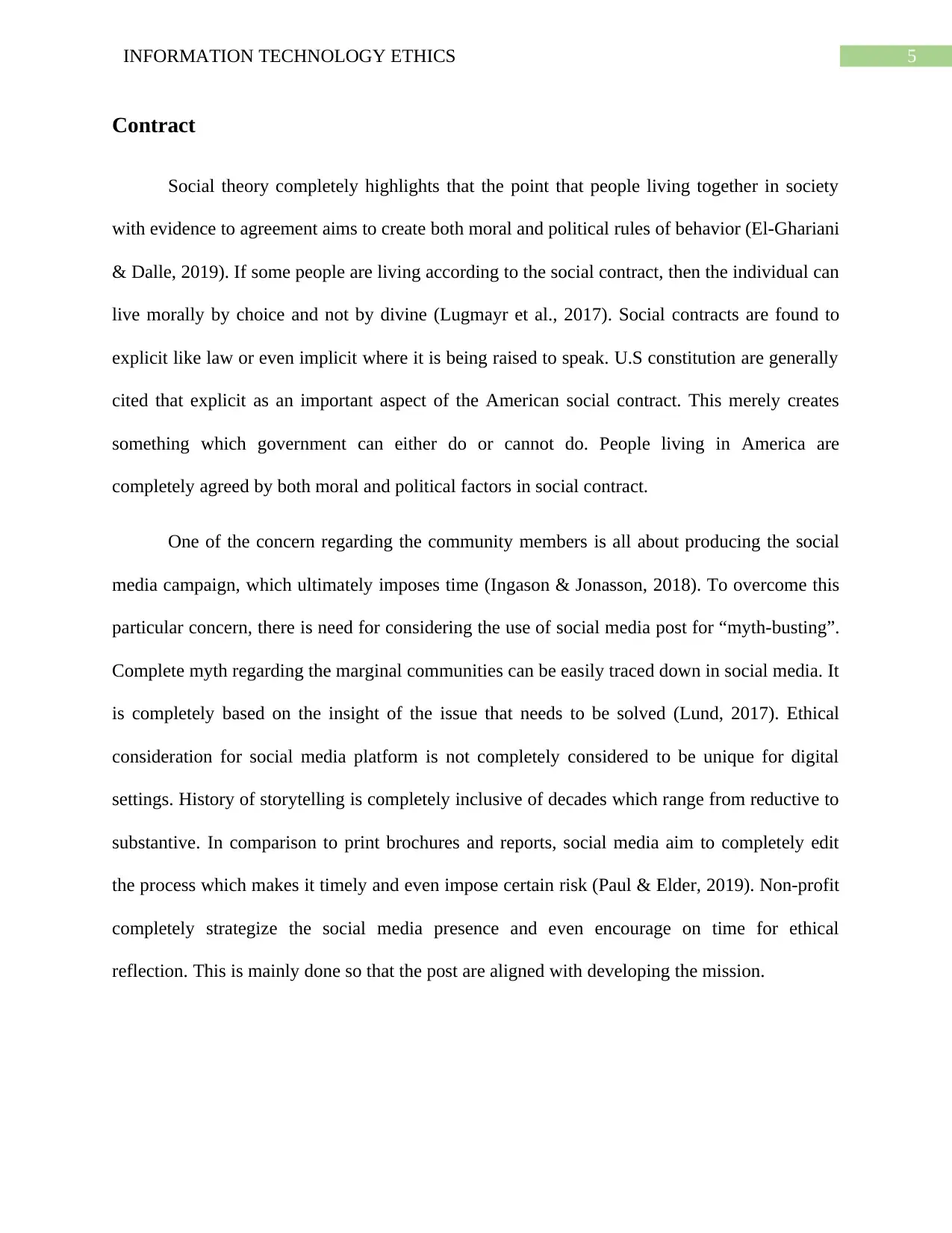
5INFORMATION TECHNOLOGY ETHICS
Contract
Social theory completely highlights that the point that people living together in society
with evidence to agreement aims to create both moral and political rules of behavior (El-Ghariani
& Dalle, 2019). If some people are living according to the social contract, then the individual can
live morally by choice and not by divine (Lugmayr et al., 2017). Social contracts are found to
explicit like law or even implicit where it is being raised to speak. U.S constitution are generally
cited that explicit as an important aspect of the American social contract. This merely creates
something which government can either do or cannot do. People living in America are
completely agreed by both moral and political factors in social contract.
One of the concern regarding the community members is all about producing the social
media campaign, which ultimately imposes time (Ingason & Jonasson, 2018). To overcome this
particular concern, there is need for considering the use of social media post for “myth-busting”.
Complete myth regarding the marginal communities can be easily traced down in social media. It
is completely based on the insight of the issue that needs to be solved (Lund, 2017). Ethical
consideration for social media platform is not completely considered to be unique for digital
settings. History of storytelling is completely inclusive of decades which range from reductive to
substantive. In comparison to print brochures and reports, social media aim to completely edit
the process which makes it timely and even impose certain risk (Paul & Elder, 2019). Non-profit
completely strategize the social media presence and even encourage on time for ethical
reflection. This is mainly done so that the post are aligned with developing the mission.
Contract
Social theory completely highlights that the point that people living together in society
with evidence to agreement aims to create both moral and political rules of behavior (El-Ghariani
& Dalle, 2019). If some people are living according to the social contract, then the individual can
live morally by choice and not by divine (Lugmayr et al., 2017). Social contracts are found to
explicit like law or even implicit where it is being raised to speak. U.S constitution are generally
cited that explicit as an important aspect of the American social contract. This merely creates
something which government can either do or cannot do. People living in America are
completely agreed by both moral and political factors in social contract.
One of the concern regarding the community members is all about producing the social
media campaign, which ultimately imposes time (Ingason & Jonasson, 2018). To overcome this
particular concern, there is need for considering the use of social media post for “myth-busting”.
Complete myth regarding the marginal communities can be easily traced down in social media. It
is completely based on the insight of the issue that needs to be solved (Lund, 2017). Ethical
consideration for social media platform is not completely considered to be unique for digital
settings. History of storytelling is completely inclusive of decades which range from reductive to
substantive. In comparison to print brochures and reports, social media aim to completely edit
the process which makes it timely and even impose certain risk (Paul & Elder, 2019). Non-profit
completely strategize the social media presence and even encourage on time for ethical
reflection. This is mainly done so that the post are aligned with developing the mission.
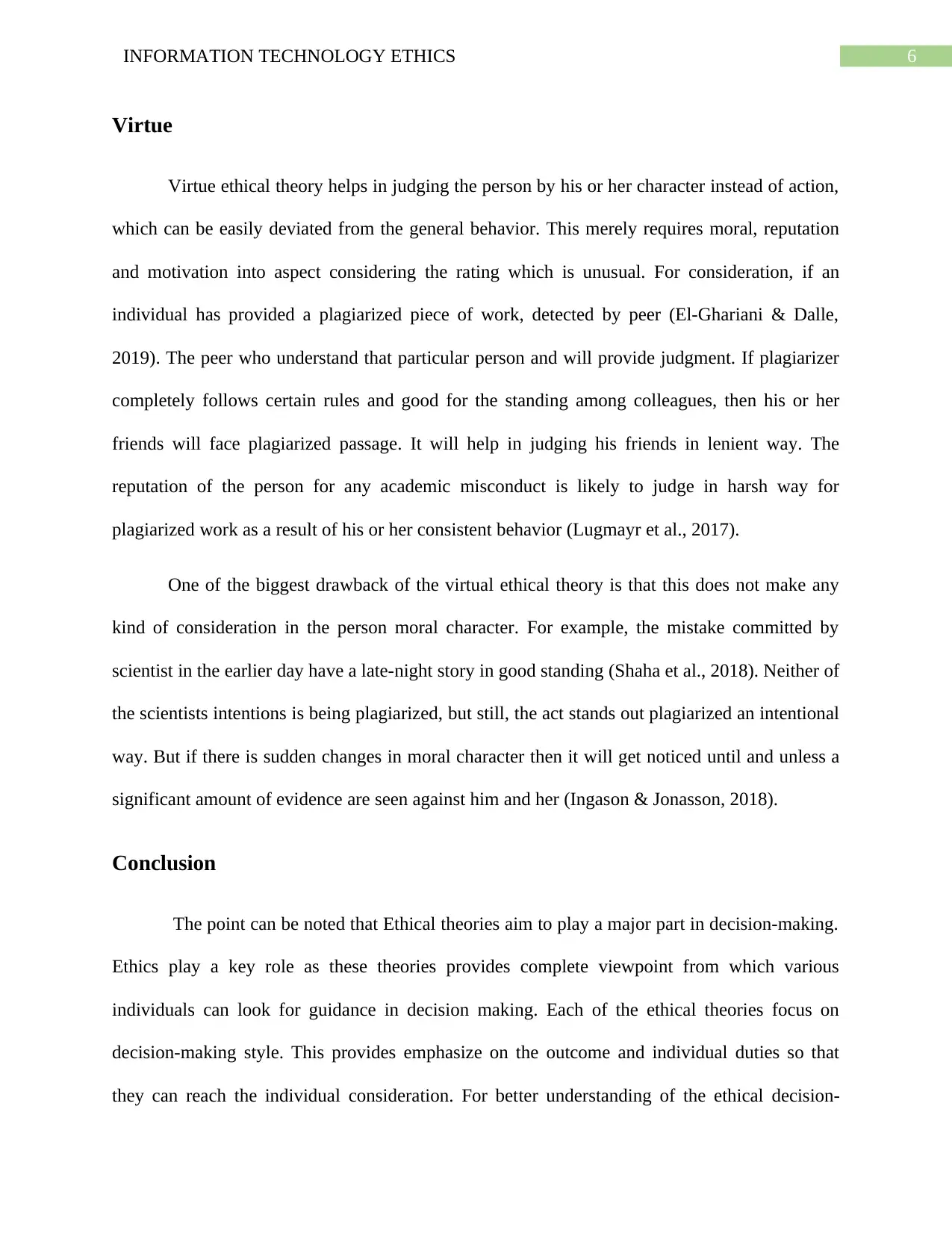
6INFORMATION TECHNOLOGY ETHICS
Virtue
Virtue ethical theory helps in judging the person by his or her character instead of action,
which can be easily deviated from the general behavior. This merely requires moral, reputation
and motivation into aspect considering the rating which is unusual. For consideration, if an
individual has provided a plagiarized piece of work, detected by peer (El-Ghariani & Dalle,
2019). The peer who understand that particular person and will provide judgment. If plagiarizer
completely follows certain rules and good for the standing among colleagues, then his or her
friends will face plagiarized passage. It will help in judging his friends in lenient way. The
reputation of the person for any academic misconduct is likely to judge in harsh way for
plagiarized work as a result of his or her consistent behavior (Lugmayr et al., 2017).
One of the biggest drawback of the virtual ethical theory is that this does not make any
kind of consideration in the person moral character. For example, the mistake committed by
scientist in the earlier day have a late-night story in good standing (Shaha et al., 2018). Neither of
the scientists intentions is being plagiarized, but still, the act stands out plagiarized an intentional
way. But if there is sudden changes in moral character then it will get noticed until and unless a
significant amount of evidence are seen against him and her (Ingason & Jonasson, 2018).
Conclusion
The point can be noted that Ethical theories aim to play a major part in decision-making.
Ethics play a key role as these theories provides complete viewpoint from which various
individuals can look for guidance in decision making. Each of the ethical theories focus on
decision-making style. This provides emphasize on the outcome and individual duties so that
they can reach the individual consideration. For better understanding of the ethical decision-
Virtue
Virtue ethical theory helps in judging the person by his or her character instead of action,
which can be easily deviated from the general behavior. This merely requires moral, reputation
and motivation into aspect considering the rating which is unusual. For consideration, if an
individual has provided a plagiarized piece of work, detected by peer (El-Ghariani & Dalle,
2019). The peer who understand that particular person and will provide judgment. If plagiarizer
completely follows certain rules and good for the standing among colleagues, then his or her
friends will face plagiarized passage. It will help in judging his friends in lenient way. The
reputation of the person for any academic misconduct is likely to judge in harsh way for
plagiarized work as a result of his or her consistent behavior (Lugmayr et al., 2017).
One of the biggest drawback of the virtual ethical theory is that this does not make any
kind of consideration in the person moral character. For example, the mistake committed by
scientist in the earlier day have a late-night story in good standing (Shaha et al., 2018). Neither of
the scientists intentions is being plagiarized, but still, the act stands out plagiarized an intentional
way. But if there is sudden changes in moral character then it will get noticed until and unless a
significant amount of evidence are seen against him and her (Ingason & Jonasson, 2018).
Conclusion
The point can be noted that Ethical theories aim to play a major part in decision-making.
Ethics play a key role as these theories provides complete viewpoint from which various
individuals can look for guidance in decision making. Each of the ethical theories focus on
decision-making style. This provides emphasize on the outcome and individual duties so that
they can reach the individual consideration. For better understanding of the ethical decision-
Paraphrase This Document
Need a fresh take? Get an instant paraphrase of this document with our AI Paraphraser
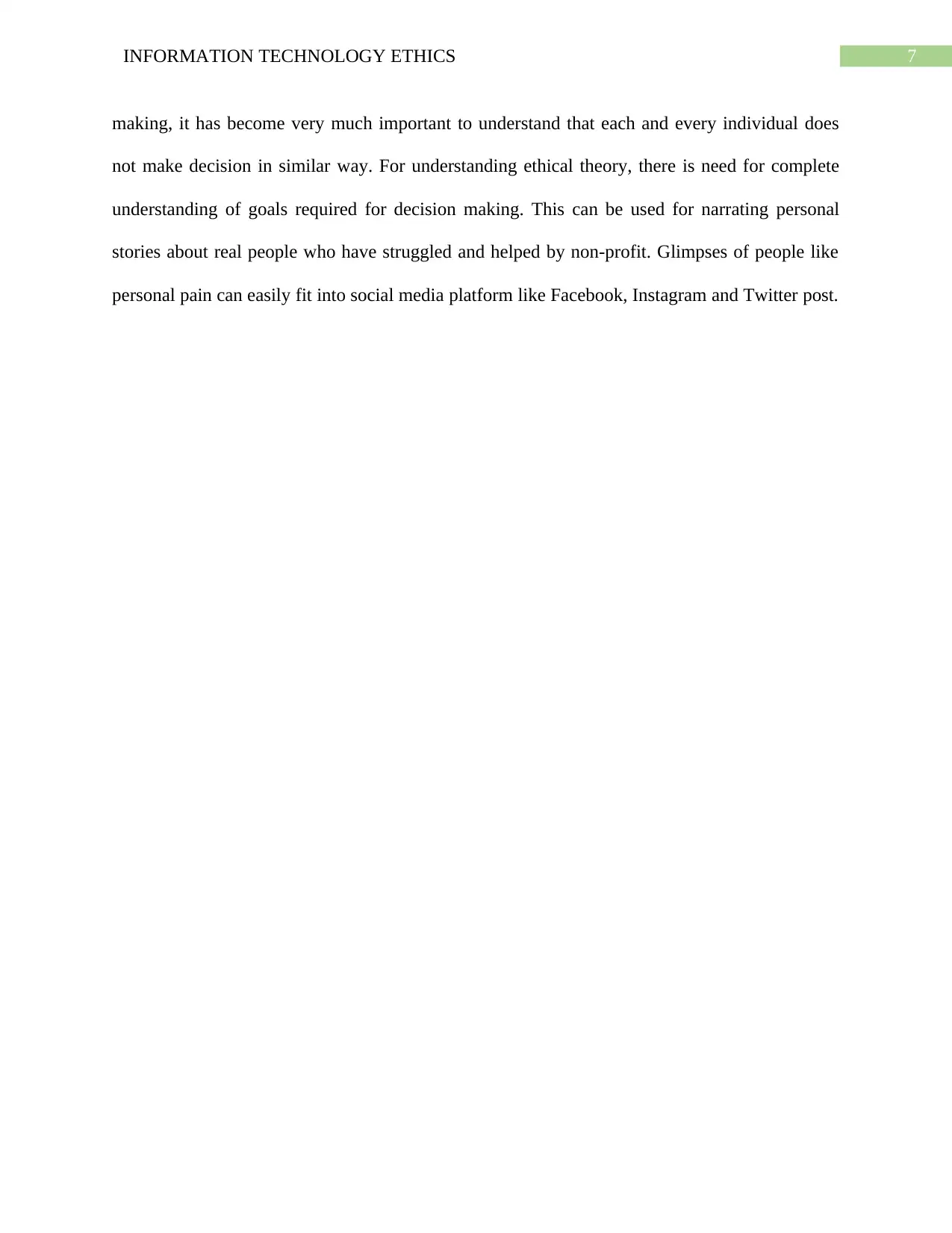
7INFORMATION TECHNOLOGY ETHICS
making, it has become very much important to understand that each and every individual does
not make decision in similar way. For understanding ethical theory, there is need for complete
understanding of goals required for decision making. This can be used for narrating personal
stories about real people who have struggled and helped by non-profit. Glimpses of people like
personal pain can easily fit into social media platform like Facebook, Instagram and Twitter post.
making, it has become very much important to understand that each and every individual does
not make decision in similar way. For understanding ethical theory, there is need for complete
understanding of goals required for decision making. This can be used for narrating personal
stories about real people who have struggled and helped by non-profit. Glimpses of people like
personal pain can easily fit into social media platform like Facebook, Instagram and Twitter post.
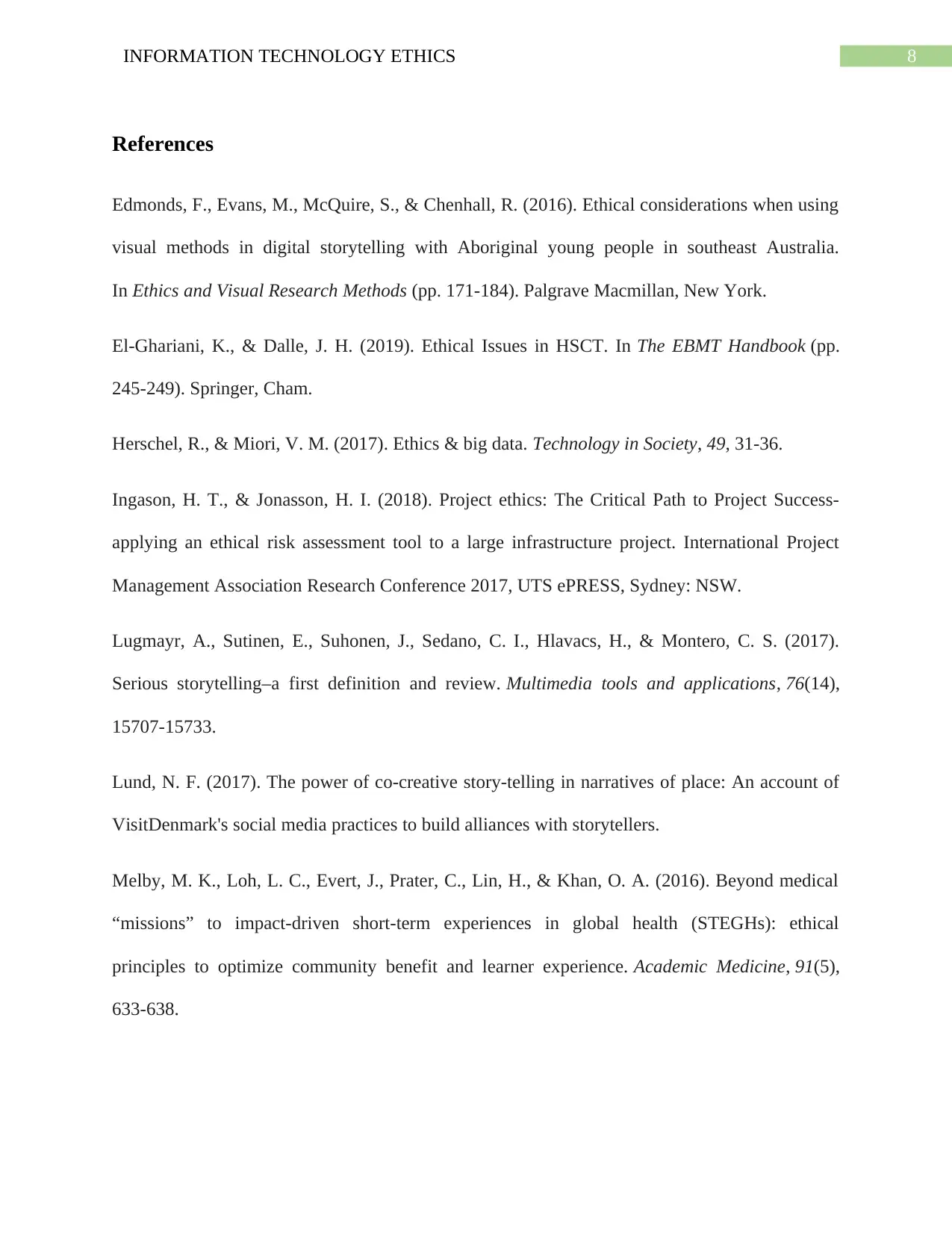
8INFORMATION TECHNOLOGY ETHICS
References
Edmonds, F., Evans, M., McQuire, S., & Chenhall, R. (2016). Ethical considerations when using
visual methods in digital storytelling with Aboriginal young people in southeast Australia.
In Ethics and Visual Research Methods (pp. 171-184). Palgrave Macmillan, New York.
El-Ghariani, K., & Dalle, J. H. (2019). Ethical Issues in HSCT. In The EBMT Handbook (pp.
245-249). Springer, Cham.
Herschel, R., & Miori, V. M. (2017). Ethics & big data. Technology in Society, 49, 31-36.
Ingason, H. T., & Jonasson, H. I. (2018). Project ethics: The Critical Path to Project Success-
applying an ethical risk assessment tool to a large infrastructure project. International Project
Management Association Research Conference 2017, UTS ePRESS, Sydney: NSW.
Lugmayr, A., Sutinen, E., Suhonen, J., Sedano, C. I., Hlavacs, H., & Montero, C. S. (2017).
Serious storytelling–a first definition and review. Multimedia tools and applications, 76(14),
15707-15733.
Lund, N. F. (2017). The power of co-creative story-telling in narratives of place: An account of
VisitDenmark's social media practices to build alliances with storytellers.
Melby, M. K., Loh, L. C., Evert, J., Prater, C., Lin, H., & Khan, O. A. (2016). Beyond medical
“missions” to impact-driven short-term experiences in global health (STEGHs): ethical
principles to optimize community benefit and learner experience. Academic Medicine, 91(5),
633-638.
References
Edmonds, F., Evans, M., McQuire, S., & Chenhall, R. (2016). Ethical considerations when using
visual methods in digital storytelling with Aboriginal young people in southeast Australia.
In Ethics and Visual Research Methods (pp. 171-184). Palgrave Macmillan, New York.
El-Ghariani, K., & Dalle, J. H. (2019). Ethical Issues in HSCT. In The EBMT Handbook (pp.
245-249). Springer, Cham.
Herschel, R., & Miori, V. M. (2017). Ethics & big data. Technology in Society, 49, 31-36.
Ingason, H. T., & Jonasson, H. I. (2018). Project ethics: The Critical Path to Project Success-
applying an ethical risk assessment tool to a large infrastructure project. International Project
Management Association Research Conference 2017, UTS ePRESS, Sydney: NSW.
Lugmayr, A., Sutinen, E., Suhonen, J., Sedano, C. I., Hlavacs, H., & Montero, C. S. (2017).
Serious storytelling–a first definition and review. Multimedia tools and applications, 76(14),
15707-15733.
Lund, N. F. (2017). The power of co-creative story-telling in narratives of place: An account of
VisitDenmark's social media practices to build alliances with storytellers.
Melby, M. K., Loh, L. C., Evert, J., Prater, C., Lin, H., & Khan, O. A. (2016). Beyond medical
“missions” to impact-driven short-term experiences in global health (STEGHs): ethical
principles to optimize community benefit and learner experience. Academic Medicine, 91(5),
633-638.
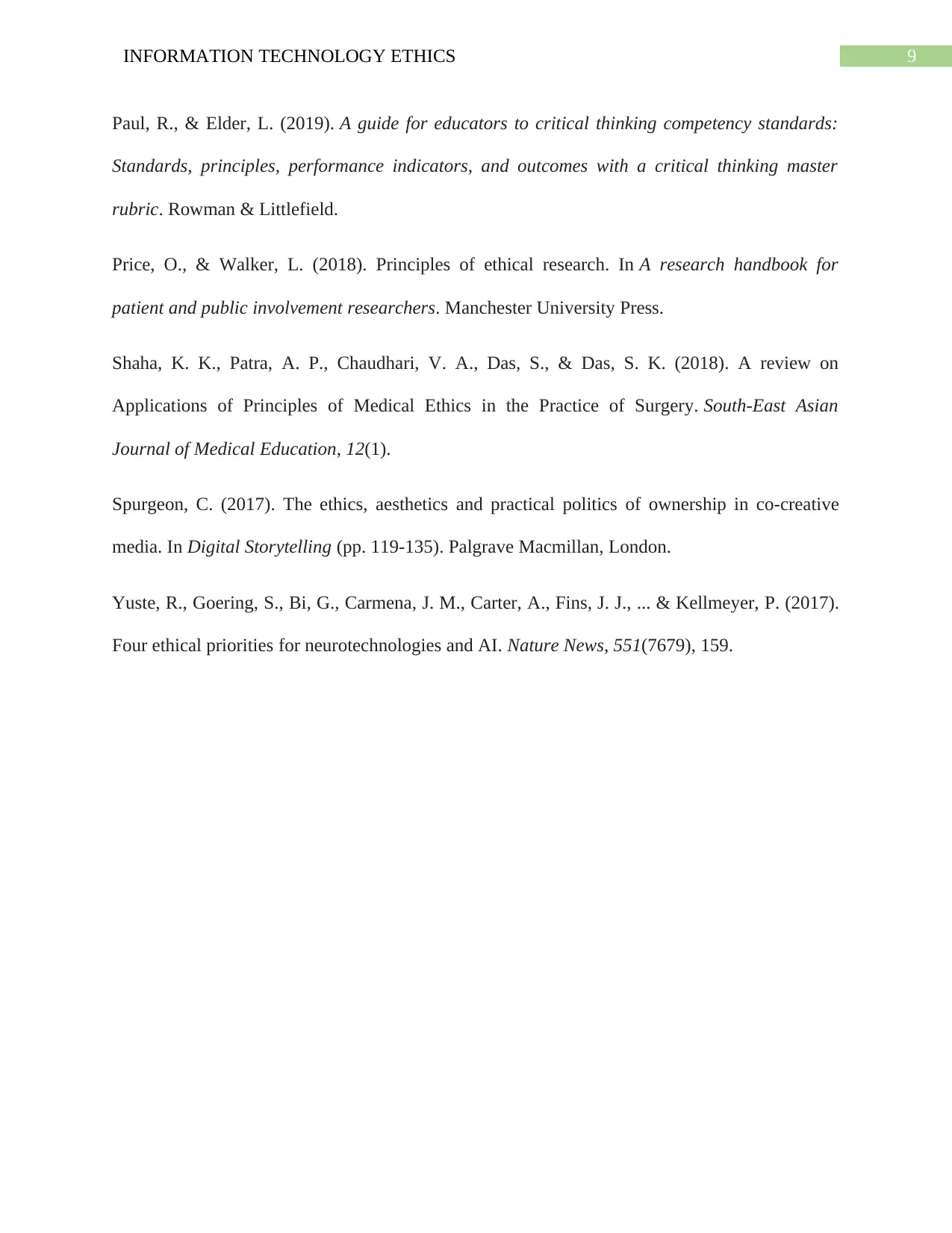
9INFORMATION TECHNOLOGY ETHICS
Paul, R., & Elder, L. (2019). A guide for educators to critical thinking competency standards:
Standards, principles, performance indicators, and outcomes with a critical thinking master
rubric. Rowman & Littlefield.
Price, O., & Walker, L. (2018). Principles of ethical research. In A research handbook for
patient and public involvement researchers. Manchester University Press.
Shaha, K. K., Patra, A. P., Chaudhari, V. A., Das, S., & Das, S. K. (2018). A review on
Applications of Principles of Medical Ethics in the Practice of Surgery. South-East Asian
Journal of Medical Education, 12(1).
Spurgeon, C. (2017). The ethics, aesthetics and practical politics of ownership in co-creative
media. In Digital Storytelling (pp. 119-135). Palgrave Macmillan, London.
Yuste, R., Goering, S., Bi, G., Carmena, J. M., Carter, A., Fins, J. J., ... & Kellmeyer, P. (2017).
Four ethical priorities for neurotechnologies and AI. Nature News, 551(7679), 159.
Paul, R., & Elder, L. (2019). A guide for educators to critical thinking competency standards:
Standards, principles, performance indicators, and outcomes with a critical thinking master
rubric. Rowman & Littlefield.
Price, O., & Walker, L. (2018). Principles of ethical research. In A research handbook for
patient and public involvement researchers. Manchester University Press.
Shaha, K. K., Patra, A. P., Chaudhari, V. A., Das, S., & Das, S. K. (2018). A review on
Applications of Principles of Medical Ethics in the Practice of Surgery. South-East Asian
Journal of Medical Education, 12(1).
Spurgeon, C. (2017). The ethics, aesthetics and practical politics of ownership in co-creative
media. In Digital Storytelling (pp. 119-135). Palgrave Macmillan, London.
Yuste, R., Goering, S., Bi, G., Carmena, J. M., Carter, A., Fins, J. J., ... & Kellmeyer, P. (2017).
Four ethical priorities for neurotechnologies and AI. Nature News, 551(7679), 159.
1 out of 10
Your All-in-One AI-Powered Toolkit for Academic Success.
+13062052269
info@desklib.com
Available 24*7 on WhatsApp / Email
![[object Object]](/_next/static/media/star-bottom.7253800d.svg)
Unlock your academic potential
© 2024 | Zucol Services PVT LTD | All rights reserved.



